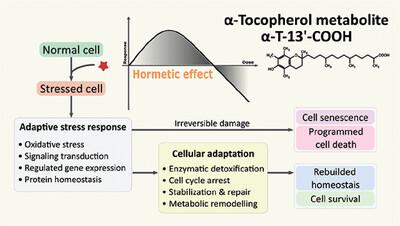当前位置:
X-MOL 学术
›
Mol. Nutr. Food Res.
›
论文详情
Our official English website, www.x-mol.net, welcomes your
feedback! (Note: you will need to create a separate account there.)
α‐Tocopherol Long‐Chain Metabolite α‐T‐13′‐COOH Exhibits Biphasic Effects on Cell Viability, Induces ROS‐Dependent DNA Damage, and Modulates Redox Status in Murine RAW264.7 Macrophages
Molecular Nutrition & Food Research ( IF 4.5 ) Pub Date : 2024-11-16 , DOI: 10.1002/mnfr.202400455 Sijia Liao, Lisa Börmel, Anke Katharina Müller, Luisa Gottschalk, Nadine Pritsch, Lara Zoé Preisner, Oleksandra Samokhina, Maria Schwarz, Anna P. Kipp, Wiebke Schlörmann, Michael Glei, Martin Schubert, Lisa Schmölz, Maria Wallert, Stefan Lorkowski
Molecular Nutrition & Food Research ( IF 4.5 ) Pub Date : 2024-11-16 , DOI: 10.1002/mnfr.202400455 Sijia Liao, Lisa Börmel, Anke Katharina Müller, Luisa Gottschalk, Nadine Pritsch, Lara Zoé Preisner, Oleksandra Samokhina, Maria Schwarz, Anna P. Kipp, Wiebke Schlörmann, Michael Glei, Martin Schubert, Lisa Schmölz, Maria Wallert, Stefan Lorkowski

|
ScopeThe α‐tocopherol long‐chain metabolite α‐tocopherol‐13′‐hydroxy‐chromanol (α‐T‐13′‐COOH) is a proposed regulatory intermediate of endogenous vitamin E metabolism. Effects of α‐T‐13′‐COOH on cell viability and adaptive stress response are not well understood. The present study aims to investigate the concentration‐dependent effects of α‐T‐13′‐COOH on cellular redox homeostasis, genotoxicity, and cytotoxicity in murine RAW264.7 macrophages as a model system.Methods and resultsMurine RAW264.7 macrophages are exposed to various dosages of α‐T‐13′‐COOH to determine its regulatory effects on reactive oxygen species (ROS) production, DNA damage, expression of stress‐related markers, and the activity of ROS scavenging enzymes including superoxide dismutases, catalase, and glutathione‐S‐transferases. The impact on cell viability is assessed by analyzing cell proliferation, cell cycle arrest, and cell apoptosis.Conclusionα‐T‐13′‐COOH influences ROS production and induces DNA damage in a dose‐dependent manner. The metabolite modulates the activity of ROS‐scavenging enzymes, with significant changes observed in the activities of antioxidant enzymes. A biphasic response affecting cell viability is noted: sub‐micromolar doses of α‐T‐13′‐COOH promote cell proliferation and enhance DNA synthesis, whereas supraphysiological doses lead to DNA damage and cytotoxicity. It hypothesizes an adaptive stress response, characterized by upregulation of ROS detoxification mechanisms, enhanced cell cycle arrest, and increased apoptosis, indicating a correlation with oxidative stress and subsequent cellular damage.
中文翻译:

α-生育酚长链代谢物 α-T-13'-COOH 对细胞活力表现出双相作用,诱导 ROS 依赖性 DNA 损伤,并调节小鼠 RAW264.7 巨噬细胞中的氧化还原状态
范围α-生育酚-长链代谢物α-生育酚-13'-羟基-染色醇 (α-T-13'-COOH) 是拟议的内源性维生素 E 代谢的调节中间体。α-T-13′-COOH 对细胞活力和适应性应激反应的影响尚不清楚。本研究旨在探讨 α-T-13′-COOH 对小鼠 RAW264.7 巨噬细胞作为模型系统的细胞氧化还原稳态、遗传毒性和细胞毒性的浓度依赖性影响。方法和结果小鼠 RAW264.7 巨噬细胞暴露于不同剂量的 α-T-13′-COOH 中,以确定其对活性氧 (ROS) 产生、DNA 损伤、应激相关标志物表达以及 ROS 清除酶活性的调节作用,包括超氧化物歧化酶、过氧化氢酶和谷胱甘肽-S-转移酶。通过分析细胞增殖、细胞周期停滞和细胞凋亡来评估对细胞活力的影响。结论α‐T-13′-COOH 影响 ROS 的产生并以剂量依赖性方式诱导 DNA 损伤。代谢物调节 ROS 清除酶的活性,观察到抗氧化酶的活性发生显着变化。注意到影响细胞活力的双相反应:亚微摩尔剂量的 α-T-13'-COOH 促进细胞增殖并增强 DNA 合成,而超生理剂量会导致 DNA 损伤和细胞毒性。它假设了适应性应激反应,其特征是 ROS 解毒机制的上调、细胞周期停滞增强和细胞凋亡增加,表明与氧化应激和随后的细胞损伤相关。
更新日期:2024-11-16
中文翻译:

α-生育酚长链代谢物 α-T-13'-COOH 对细胞活力表现出双相作用,诱导 ROS 依赖性 DNA 损伤,并调节小鼠 RAW264.7 巨噬细胞中的氧化还原状态
范围α-生育酚-长链代谢物α-生育酚-13'-羟基-染色醇 (α-T-13'-COOH) 是拟议的内源性维生素 E 代谢的调节中间体。α-T-13′-COOH 对细胞活力和适应性应激反应的影响尚不清楚。本研究旨在探讨 α-T-13′-COOH 对小鼠 RAW264.7 巨噬细胞作为模型系统的细胞氧化还原稳态、遗传毒性和细胞毒性的浓度依赖性影响。方法和结果小鼠 RAW264.7 巨噬细胞暴露于不同剂量的 α-T-13′-COOH 中,以确定其对活性氧 (ROS) 产生、DNA 损伤、应激相关标志物表达以及 ROS 清除酶活性的调节作用,包括超氧化物歧化酶、过氧化氢酶和谷胱甘肽-S-转移酶。通过分析细胞增殖、细胞周期停滞和细胞凋亡来评估对细胞活力的影响。结论α‐T-13′-COOH 影响 ROS 的产生并以剂量依赖性方式诱导 DNA 损伤。代谢物调节 ROS 清除酶的活性,观察到抗氧化酶的活性发生显着变化。注意到影响细胞活力的双相反应:亚微摩尔剂量的 α-T-13'-COOH 促进细胞增殖并增强 DNA 合成,而超生理剂量会导致 DNA 损伤和细胞毒性。它假设了适应性应激反应,其特征是 ROS 解毒机制的上调、细胞周期停滞增强和细胞凋亡增加,表明与氧化应激和随后的细胞损伤相关。


















































 京公网安备 11010802027423号
京公网安备 11010802027423号